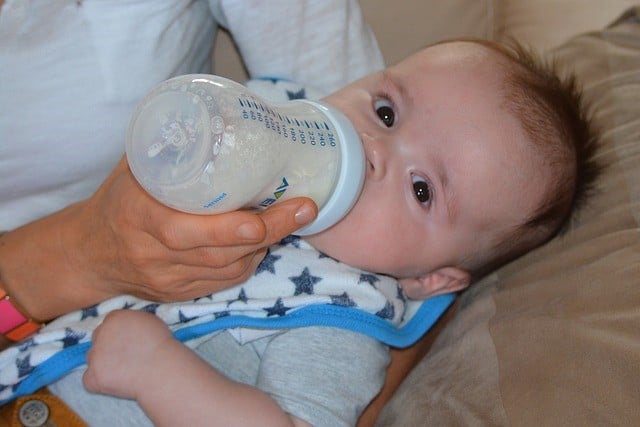Breastfeeding is the process of feeding a mother’s milk to her baby, typically directly from her breasts. Considered the most natural, convenient, and cost-effective way to nourish a baby, experts agree that babies should be breastfed exclusively for at least six months. However, mothers may not always be able to nurse after giving birth or may decide to wean the baby prematurely for a variety of reasons.
If you have stopped breastfeeding after some time (weeks or months) and wanted to give it another shot, the good news is most mothers can partially or fully relactate. It is never too late to start breastfeeding according to the experts. This means that a late start at breastfeeding is attainable with patience, persistence, and a substantial support system.
Breastmilk contains important antibodies to fight off bacteria and viruses, as well as lowers babies’ risk of having allergies or asthma. Apart from this, breastfeeding strengthens the bond mothers share with their babies.
Read on to find out how it is possible to restore breastmilk supply even after a considerable gap. Adoptive mothers can also feed their baby with their own breastmilk. Listed here are some of the best tips for successful relactation.
Common Reasons Why a Mom Would Want to Restore Her Milk

There are different reasons why some mothers are unable to breastfeed their babies. These include severe postpartum depression or other maternal medical issues, premature babies, inability of the infant to latch effectively, as well as in the case of adoptive mothers or babies born to a surrogate parent.
Many women also try breastfeeding exclusively early in infancy, but have to wean early as well, either by choice (need to go back to work) or not (lack of substantial milk supply).
There are other instances where a mother has intended to use formula milk and started bottle-feeding, but the baby does not tolerate the formula well.
No matter the reason, re-establishing your milk supply to breastfeed your baby is possible. The sooner you start the process, the more likely you will succeed in your relactation journey.
When Is It Too Late to Start Breastfeeding?

If you want to give breastfeeding another shot, it is possible even after weeks or months of not breastfeeding. The process is called relactation.
A two-fold approach, relactation involves inducing or bringing back the mother’s milk supply, and then getting the baby to feed again on the milk produced.
Both are also interdependent with one another. The more the baby sucks, the more milk is produced. In turn, the more milk is produced, the greater the baby’s urge will be to breastfeed.
You have the best chances of relactation success if:
- Your baby is below six months old, which applies to adopted babies, too
- You have lesser lactation gap
- You have initiated breastfeeding before, even if it only lasted for a few days
- Your baby was able to breastfeed in the first few days of life, but for some reason had to be switched to formula milk
- You are determined and committed to start breastfeeding again
The more educated you are about relactation and how it works, the more likely you are to succeed. Also, enlisting help from trained breastfeeding support professionals can help you overcome the initial challenges of relactation.
The moment you begin nursing less often or cease breastfeeding altogether, your breastmilk supply also decreases. If you want to give breastfeeding another try, you will have to re-establish your milk supply. In most cases, mothers who have the right support and proper guidance before taking on the relactation journey have the best chances of success.
Breastfeeding an Adopted Baby

It may be surprising, but it is possible to initiate breastmilk supply without giving birth or having a recent pregnancy. Therefore, even an adoptive parent to a baby who has been previously bottle-fed can succeed at breastfeeding.
This is referred to as induced lactation. Babies are hardwired to breastfeed. Breastfeeding an adopted baby, or one born to a surrogate parent, provides needed nutritional benefits generated from the breastmilk and can strengthen the mother-baby relationship.
Much like relactation, induced lactation is attainable through nipple stimulation. There are also herbal remedies and prescription medications that can aid in boosting milk production. It is always a good idea to seek help from a qualified lactation consultant or breastfeeding health professional to get expert advice, as mothers navigate through the issues and complexities of breastfeeding.
Tips for Relactation Success

While different factors can affect relactation, available studies show that the success rate of relactation is encouraging.
Mothers with older babies, those who have not established a good milk supply beforehand, and adoptive mothers who have never breastfed, can all get good relactation results.
-
Pump every so often
Breastfeeding works based on supply and demand. Pumping frequently can stimulate your milk production allowing you to produce ample milk supply.
Don’t get discouraged if, in the beginning, you are only producing such a small quantity of milk that you will need to squint to see if you’ve produced any in the bottle. Keep working at it, and in time you should be able to establish a great supply.
-
Strategize feeding times
Try to feed the bub when he is not very hungry, and your breasts have an ample supply of milk – early in the morning or during the night. Babies also tend to latch more when they are half asleep. Use this opportunity, such as right after they wake up or in the middle of the night, to breastfeed.
-
Check your diet and make sure you are getting enough rest
Eating a healthy diet is crucial for breastmilk production, as is having enough sleep and rest. If you are too exhausted or stressed, your attempts of increasing your milk supply will be futile, as stress and fatigue are well-known to affect the production of a healthy breastmilk supply.
-
Increase your fluid intake
Not only will you need extra hydration when you are breastfeeding, but fluids can also help stimulate a fast letdown and boost your milk supply. If drinking lots of water isn’t your thing, try beverages that help stimulate milk production, like the organic Milkmaid herbal tea by Earth Mama.
-
Breast compression
Done by gently compressing and squeezing the breast during breastfeeding, breast compression can be a useful technique to increase milk flow. Hence, the baby gets more milk, which in turn, encourages him to keep sucking actively. This also increases the feeding frequency, and since the breasts are emptied regularly, the production of milk increases.
-
Limit bottles and pacifiers
Remember to offer the breast first, be it for feeding or for when the child needs some comfort. Otherwise, offer your baby his feedings through alternative nursing methods. This includes cup-feeding, spoon-feeding, or a nursing supplementer. Use these alternatives rather than bottles and pacifiers, which can cause nipple confusion and prevent babies from breastfeeding well.
-
Consider galactagogues
Many mothers swear by the positive results of using herbal supplements, also referred to as galactagogues, during their relactation journey. Some of the herbal supplements that are known to help stimulate milk production include fenugreek, blessed thistle, alfalfa, and fennel.
Keep in mind, though, that using galactagogues alone will not be enough. Frequent breast stimulation through nursing and/or pumping is essential to get good results.
-
Make sure your baby is still well-fed
As you strive to achieve your goal of re-establishing your milk supply so you can start breastfeeding again, make sure that your little one still gets the right amount of supplementary milk to keep him healthy and growing.
Expert Tips for Breastfeeding After Bottle Feeding

Although there is a bit more work required to switch from bottle-feeding to breastfeeding exclusively, particularly among older babies, many experts say this is workable.
Below are some tips to reintroduce breastfeeding after bottle-feeding:
-
Take it easy and relax around your baby
It is best not to force the baby into breastfeeding. After making several failed attempts, it can be frustrating to coax a baby to breastfeed. This is understandable.
The most important thing is to keep at it and to take it easy. Before nursing, take three long and slow deep breaths to calm yourself down. Meditation and playing soothing music can also help you relax.
-
Lots of skin-to-skin time
Put the baby to the breast as often as possible, even if it is not feeding time yet. Spending lots of time while holding the baby tummy-down on your semi-reclined body releases the instinctive feeding reflexes that encourage them to latch and suckle.
-
Utilize nipple shield
Bottle-fed babies may be used to the feeling of the bottle’s harder silicone nipple. Nipple shields feel similar to bottle teats. When applied correctly, a nipple shield can be used to encourage a reluctant baby to accept the breasts.
-
Let your baby lead
Lay back and let your baby take control of when and how he wants to latch. Also known as biological nurturing, this is best done skin-to-skin. The laid-back position also gives the added benefit of being able to relax and snuggle your little one as you feed him hands-free.
-
Give your breasts extra stimulation
You will need the extra stimulation so that when your baby starts to latch, your milk supply will be up to his demand.
Encouraging the Baby to Accept the Breast

Another essential aspect of the relactation process is getting the baby to latch. You will want your baby to enjoy the breast. Anything you can do so that breastfeeding does not become a battleground will be helpful.
Try the following methods to entice your bub to latch and feed on your breastmilk:
- Get more skin-to-skin contact and present opportunities gently. Skin-to-skin contact promotes oxytocin, which promotes milk supply.
- Try co-bathing.
- Use the power of your voice. Sing or talk to your baby softly to relax your baby when it is feeding time.
- Keep the bub on or as close to your body as much as possible. Here is where babywearing can be especially beneficial.
- Squeeze a little milk from your nipple first before offering your breasts.
How Long Does Relactation Take?
Every woman’s body will respond differently to relactation attempts. Generally, one can expect to see positive results within two weeks of attempting to relactate.
According to experts, most mothers who plan to relactate can take up to one month to be successful. Allow yourself enough time to reach your goal, instead of expecting too much from yourself or your baby too soon.
Proper guidance, good information, and professional support are needed to accelerate your success in reestablishing a breastfeeding pattern.
Don’t be too hard on yourself. If after doing your best, you are not able to bring in a full supply of milk, know that any amount of breastmilk generated will be valuable. Additionally, breastfeeding is not solely about the milk produced. The act of breastfeeding alone can be a great way to develop a deeper bond with your little one.
What is the Composition of Milk During Relactation?
Whether it is produced after the baby’s birth, or later on following relactation or induced lactation, breastmilk composition remains the same.
Generally, mothers who had not been pregnant and relactate do not produce colostrum, which is the first milk produced during the first several postpartum days and contains high concentrations of nutrients and antibodies. Instead, their milk is similar to transitional or mature milk.
Is It Ever Too Late to Start Breastfeeding?

You have the best chances to be successful at late breastfeeding if your baby is below 6 months of age. Those with babies who are 3 to 4 months old show even more increased success rates. Relactation can also more likely be successful if you had a well-established breastfeeding pattern during the first four to six weeks postpartum.
It can be harder to persuade a baby who is above 6 months old to latch, specifically those who have been accustomed to feeding on a bottle.
Moreover, some mothers may not be able to bring in a full milk supply. But even so, a partial milk supply can make a significant difference to a baby’s health and development.
Success rates for relactation vary. But you will never know how your body will respond unless you give it a try. Allocating lots of time for pumping and attempting to breastfeed several times within a day are great help for stimulating and establishing breastmilk supply.
Final Thoughts
Although it may not be easy, relactation and reintroducing breastmilk to your baby after a gap, and even inducing lactation without having given birth is possible. Be patient. Understand that late breastfeeding generally requires time and dedication to achieve. With the right mindset and support, and following our advice and tips above, it is never too late to start breastfeeding.
